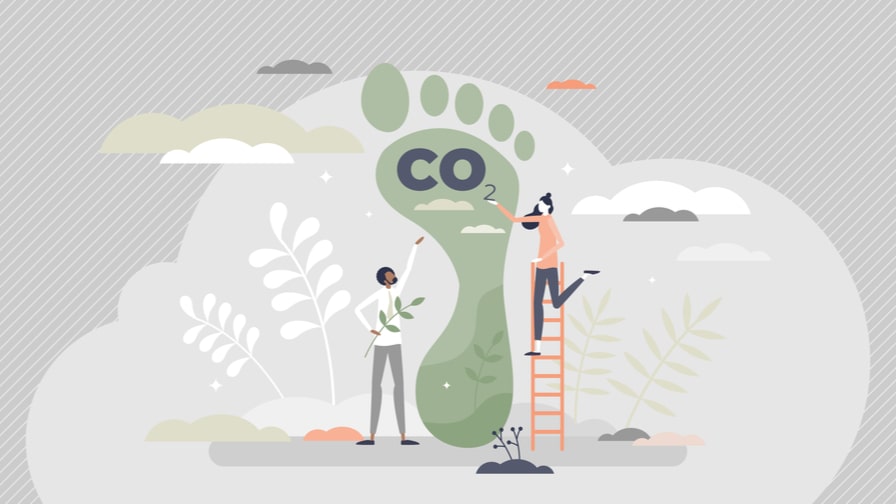At the end of last year, the BBC reported that internet usage in the UK had more than doubled in 2020 due to the pandemic. However, each of these seemingly harmless online activities come at a cost. Recent figures reveal that internet usage has an annual carbon footprint of more than 830 million tons globally. To put that into perspective, the aviation industry had a carbon footprint of 920 million tons in 2019.
While the energy needed for a single internet search or email is minimal, the number of UK internet users is projected to increase to 88.7% of the country’s population by 2025. Those scraps of energy and the associated greenhouse gasses emitted with each online activity rapidly begin to add up.
While many organisations have made significant progress over recent years in the push to become more eco-friendly, a recent study of marketing professionals by the WFA revealed many gaps remain in brands’ collective journey to a more sustainable future. Climate change and environmental degradation are two of the greatest challenges of modern times, and while we can’t single-handedly change the whole world when it comes to sustainability – we can make sure we manage our own slice of it and start to bring our collective emissions down. As such, even small improvements like following SEO best practices can multiply into real effective change.
How can SEO help the environment?
A solid SEO strategy goes far beyond keywords and links. It means optimising every inch of your online presence so that a website is not only discoverable to users, but also builds trust and credibility – ultimately helping you stand out from competitors. From an environmental standpoint, a good technical SEO strategy means that energy consumption is naturally lowered as it aims to improve page speed by reducing the number and size of assets that need to be loaded. As a result, faster, higher performance websites also have lower bounce rates, meaning a user is less likely to visit another website to complete their intended goal.
These user experience considerations, along with making content findable through a well-thought-out navigation, with no broken links or unnecessary redirects, aims for a fluid customer journey. This fluidity allows users to reach their destination, all while loading the fewest and most energy efficient pages as possible.
Not only is making speed efficiencies the responsible thing to do, but it will help marketing efforts too. With Google’s Core Web Vitals algorithm update starting to roll out, a faster, more energy efficient website has never been more important for organic performance. A faster website is not only beneficial for SEO and customer experience, but can positively impact paid campaigns, as reducing load times have also been shown to boost the quality score of landing pages. One client saw a Cost Per Click (CPC) decrease of 62% for an ad group after a +3 point improvement of the mobile speed score on the campaign landing pages.
The impact of a faster, more efficient website goes way beyond SEO metrics. Over recent years, we’ve seen significant growth in the priority given to corporate social responsibility by companies, as consumers and employees demand businesses take interest in more than just profits. Research shows that sustainability and purpose now drive purchasing decisions, with an IBM survey finding that four in 10 users make their primary purchasing decisions in a purpose-driven way – the same number that are driven by value/cost. Reducing a brands website carbon emissions is a necessary step in sustainability transformation that customers now expect from the brands that they love.
Investment in ECO SEO & measuring its ecological impact
With many speed improvement recommendations often requiring significant investment, sustainability is an additional factor to deploy when convincing non-technical stakeholders of the need for site speed updates. While it might not be a deciding factor of its own, effectively communicating the additional benefits of improved page speed will get attention from other areas of the business. Communicating the impact of your commitment to sustainability is essential to reap the additional benefits – helping improve employer branding as well as both internal and external PR.
When it comes to measurement, up until recently it’s been extremely difficult to measure what the emissions from a particular site might be. While there are now many tools on the market that can estimate these emissions using data sources, including the energy source used by services and traffic volume, this is not yet precise. By taking a more top-level view, we can assess the impact of implementations which we know will make websites more efficient, such as a reduction in the number of server requests.
Building a ‘better web’
Google has long talked about building a ‘better web’ – whether trying to eliminate spam content from ranking in its search results or encouraging businesses to build responsive and secure websites, the focus has usually been on a user’s online experience. Recognising there is a bigger sustainability picture which can be considered by businesses takes our understanding of a ‘better web’ beyond things like speed metrics and which protocol is used.
It might seem like a small step to take in the drive for greater sustainability, but when it comes to reducing the impact of people’s behaviour on the environment, when taken together, lots of small steps can make a dramatic difference. Not only are brands increasingly assessed by customers by their social purposes, but companies are also being weighed in the financial markets by their focuses on Environmental and Social Governance (ESG). These efforts reinforce better actions and responsibilities which can be taken throughout a business when it comes to taking steps towards a better world.
